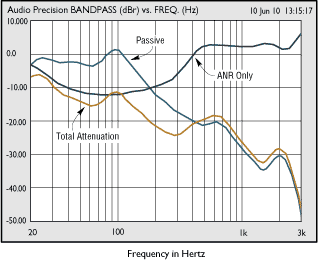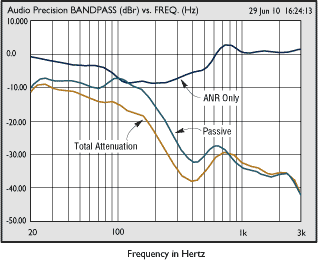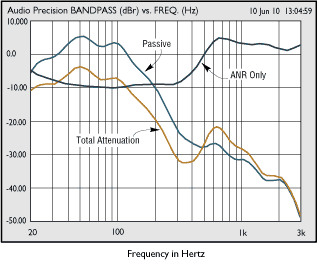Passive vs. Active
Understanding and comparing cancellation specifications
Section 1 of this series dealt with different components that influence ‘quietness’.
The focus of this session is to show what passive and active attenuation are and how they affect the total cancellation.
Before going any farther, let me cover what we mean when using the terms “Passive” and “Active” attenuation. We use these words to describe how much noise is eliminated by the ‘physical’ characteristics of the headset (passive) and how much is reduced via the ‘electronic’ cancellation (active) generated within each dome. This cancellation can be measured and graphed…typically using noise levels (in dB) on one axis and frequency on the other. These characteristics are unique to each headsets style/shape/design. These two attenuations, when graphed and overlaid, form the basis for any claims of ‘total’ cancellation.
Before we address the issue of advertised claims on various models, let’s look and compare data on cancellation for different products. Below is a set of attenuation graphs for three different headset designs. For each platform, the graph lines show Active performance, Passive only, and a third line showing the combined or Total Attenuation.
Headset #1

Headset #2

Headset #3

There are several interesting things worth noting about these results. Headset graph #1 with the greatest active performance is actually the WORST for Total Attenuation. Headset graph #2 provides the lowest Active performance yet yields the BEST overall quieting! We’ll cover the reasons for this later on in this tutorial. The headset on graph #3 is quieter than #1 at frequencies above 300Hz but the passive performance was severely compromised by the conversion to an active product.
What about just adding the active and passive claims together to determine which is quieter?
This is a misleading practice and leads to false conclusions. The reasons for this were covered in some detail at the end of Section 2 of ANR 101. In summary, the active number is typically a single dB number that represents a frequency where active reduction is maximized. This ignores the breadth of cancellation provided and overlooks both positioning of the cancellation and boosting issues (both covered in some detail in Section 1 of ANR101). Typically manufacturers advertise a ‘range’ of peak cancellation as a reference. Depending on the test fixturing and measurement techniques, there can be substantial differences in results. Remember (from ANR101, Sec 1) the importance of good correlation between the sensing mic and your ear canal. The positioning of this mic effects the measured results for cancellation. It might cancel great at the microphone but not as much in your ear! In the final analysis, those numbers are only somewhat helpful in comparing different brands but ONLY for their active performance.
Passively, the story gets even more confusing. First, a bit of history on the passive noise reduction ‘standard’. In the traditional ‘passive’ headset market, there has been a longstanding test standard set up by the EPA as an industrial standard for measuring hearing protection…the “Noise Reduction Rating” (NRR). This was the most popular means of comparison for passive headsets in the 80’s and 90’s. Today, most passive headsets make some claim about passive noise reduction. In reality, less than half of the models sold actually have test data to support their claim. Many publish a number like ” 24dB” but make no “NRR” claim. Others do imply some “NRR” rating but have no specific, by Model, test data. Recently others have published a “SNR” number…a attenuation rating system gaining popularity in Europe. While not inappropriate, these numbers become misleading since “SNR” tests routinely will produce higher dB reduction numbers than traditional “NRR” measurements.
This information (or lack there of) becomes important when trying to assess the passive performance of the ANR models available on the market. As of this printing, no supplier had actually published “NRR” data for the passive performance of their ANR headset. One reason might be that the passive performance goes down NOTICEABLY when a passive headset is modified to become an active one. We’ll cover the acoustic reasons for that in more detail in Section 3. Suppliers might be reluctant to acknowledge that reduction openly…it wouldn’t help sell headsets!! Instead, those that had a passive model will reference their claims for passive performance without actually saying that it IS the passive performance. i.e. “We’ve added 14 dB of active performance to our 23dB NRR passive headset” Notice they don’t actually SAY their ANR model has 23dB NRR rating…but it’s implied.
Test data between Active and Non-Active versions of identical platforms (covered in the next section) prove this point. At specific frequencies, the deviation can exceed 10dB. The reduction in passive attenuation of the ANR version will depend on how the active electronics module is implemented inside the dome(s). On average the Noise Reduction Rating (NRR) of the active version would be 2-6dB less than it’s passive version.
I’m sure you’re beginning to see why confusion abounds in adding active and passive numbers. The active number…while technically accurate, provides only a partial indication of how effective the overall ANR electronics are. The passive numbers are flawed because there are no actual NRR ratings and then for some, the rating referenced wasn’t even an actual measure of the passive platform! Without being redundant, the only sure way to get good comparative data is to try on several models and compare them side by side. That can be done at major trade shows, or some of the larger pilot supply stores, or possibly by meeting up with fellow pilots who already have ANR headsets.
Section 3 of this series deals with the acoustic tradeoffs relating to Active and Passive performance. It specifically deals with Ear cavity volume and Ear Seal design/comfort.









